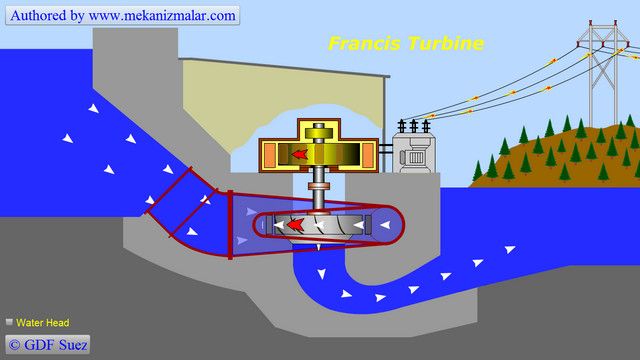Francis Turbine
There are three major types of water turbines. The Pelton turbine requires large water head and low flow rate, and the Kaplan turbines require low water head but a large flow rate. The Pelton turbines usually build in mountainous regions, while the Kaplan turbines are located in lowlands. These restrictions make these two kind turbines less common than the Francis Turbine.
The Francis turbine fills a large gap between the Pelton and Kaplan and it is widely used. They operate in water head from 10 to 600 meters, and are primarily used for electric power generation. Their power output can be calculated from the water head and flow rate and typically range from 10 to more than 700 megawatts. One of the distinct advantages of the Francis turbine with respect to other water turbines is that they can also be used as water pump. This makes them ideal for a pumped storage systems.
This animation shows the operation of a Francis Turbine in a dam. The arrows show the water path and direction inside the dam. The water from the reservoir behind the dam is transferred to the turbine by a penstock. The penstock diameter of a Francis turbine could be as large as 10 meters. The water coming from the penstock is transferred to the inlet scroll, which distributes the water equally around the wicket gates. Water passes through the wicket gates, which controls the amount of water passing through the turbine, before reaching the runner. This in effect controls the power output of the dam. The wicket gates also adjust the angle of the water reaching to the runner.
After passing through the wicket gates, the water reaches the runner. The water pressure forces the runner to rotate. The rotation speed of the runner can be in the range of 80 to 1000 revolutions per minute. The water continues its motion downward under the runner to the exit pipe. The exit pipe discharges the water to the environment as low pressure water.
The turbine shaft of the Francis turbines is almost always mounted vertically. This makes discharge of the water much easier due to the swirling effect of the water in the inlet scroll, and the effect of gravity.
The rotational motion of the runner is transferred to an electric generator shown. The generated electricity is converted to a high voltage current and is transferred to the grid to be consumed.
One big advantage of the water turbines is that power output can be regulated very easily. If the demand is reduced, the amount of water flowing to the turbine can be reduced in a relatively short period of time.
